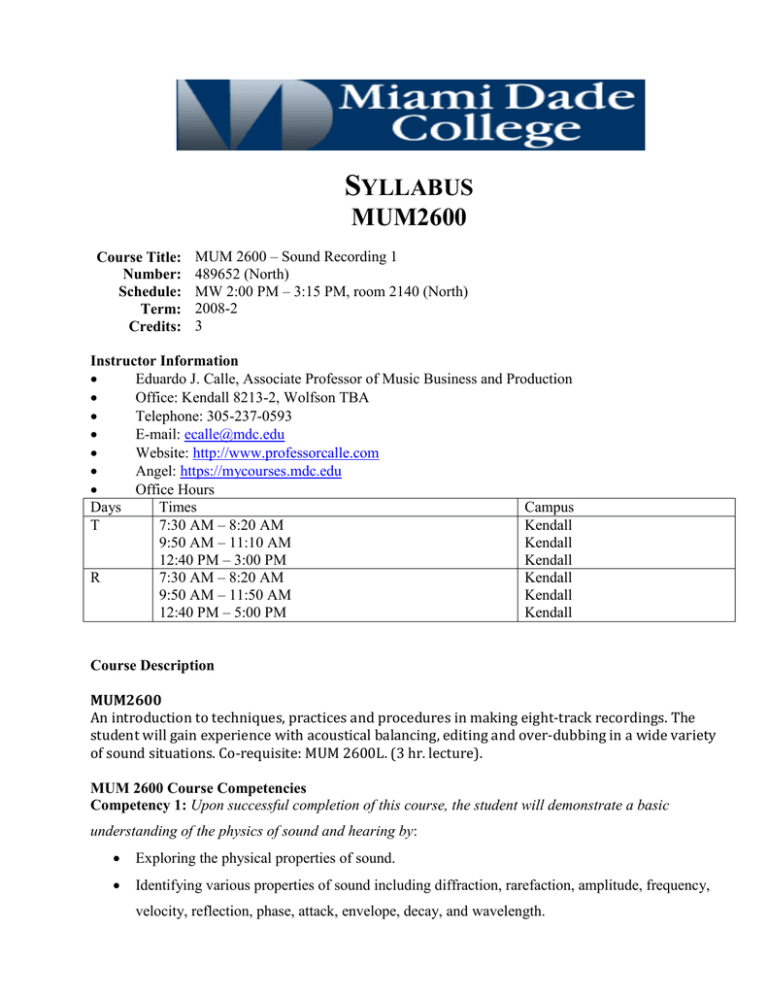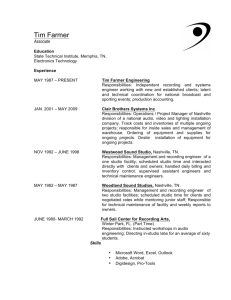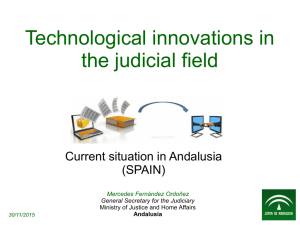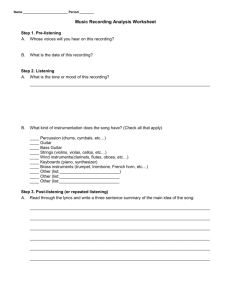MUM2600_Calle_syllabus_08_2 copy
advertisement

SYLLABUS MUM2600 Course Title: Number: Schedule: Term: Credits: MUM 2600 – Sound Recording 1 489652 (North) MW 2:00 PM – 3:15 PM, room 2140 (North) 2008-2 3 Instructor Information Eduardo J. Calle, Associate Professor of Music Business and Production Office: Kendall 8213-2, Wolfson TBA Telephone: 305-237-0593 E-mail: ecalle@mdc.edu Website: http://www.professorcalle.com Angel: https://mycourses.mdc.edu Office Hours Days Times Campus T 7:30 AM – 8:20 AM Kendall 9:50 AM – 11:10 AM Kendall 12:40 PM – 3:00 PM Kendall R 7:30 AM – 8:20 AM Kendall 9:50 AM – 11:50 AM Kendall 12:40 PM – 5:00 PM Kendall Course Description MUM2600 An introduction to techniques, practices and procedures in making eight-track recordings. The student will gain experience with acoustical balancing, editing and over-dubbing in a wide variety of sound situations. Co-requisite: MUM 2600L. (3 hr. lecture). MUM 2600 Course Competencies Competency 1: Upon successful completion of this course, the student will demonstrate a basic understanding of the physics of sound and hearing by: Exploring the physical properties of sound. Identifying various properties of sound including diffraction, rarefaction, amplitude, frequency, velocity, reflection, phase, attack, envelope, decay, and wavelength. 2 Computing changes in the velocity of a sound wave in terms of feet per second squared based on temperature expressed in degrees Fahrenheit. Computing the length of an acoustic wave by dividing the given velocity of a sound wave by its corresponding frequency and discussing the application of such a computation in studio design. Comparing simple and complex sound waves and analyzing the most common type of sound wave encountered by commercial recording engineers. Identifying various components of the human ear from a diagram. Expressing the range of human hearing in terms of acoustic frequencies measured in hertz. Defining various frequency values expressed in hertz to corresponding MIDI note numbers on a piano keyboard. Expressing the threshold of hearing in terms of sound pressure levels measured in decibels and identifying commonly available sound sources producing such decibel levels. Expressing the threshold of feeling in terms of sound pressure levels measured in decibels and identifying commonly available sound sources producing such decibel levels. Expressing the threshold of pain in terms of sound pressure levels measured in decibels and identifying commonly available sound sources producing such decibel levels. Listing and defining the basic characteristics of sound including sound pressure waves, cycles, periods, amplitude, frequency, and phase. Articulating the basic concepts associated with the measurement of sound pressure levels in decibels. Articulating the basic concepts associated with the measurement and description of frequencies in hertz. Recording and examining simple and complex waveforms. Comparing loudness of recorded sound measured in decibels to the loudness of acoustic sources encountered in daily life. Defining spatial perception in terms of monaural and stereo audio imaging. Competency 2: Upon successful completion of this course, the student will demonstrate a working knowledge of the recording process by: Identifying various areas and components of a recording studio from diagrams, floor plans, discussions, pictures, and written descriptions. Defining at least three skills and responsibilities of a recording musician, studio manager, record producer, and recording engineer via the completion of a written report referencing at least two 3 sources including but not limited to interviews with professional musicians, trade publications, print and electronic articles, audio recording liner notes, and textbooks. Detailing the chain of command in the recording process based on various scenarios suggested by the instructor in situational, written, and/or oral form. Competency 3: Upon successful completion of this course, the student will demonstrate a basic understanding of the requirements associated when designing a project studio by: Performing a needs assessment for a home or project studio. Detailing in writing the exact appropriation of a suggested studio budget intended to maximize the capabilities of a home or project studio in accordance with the findings of the needs assessment. Producing a simple diagram of a student-designed project studio detailing the physical dimensions of the facility and a layout of the studio’s recording and monitoring equipment. Researching and documenting costs associated with acoustic design and materials, wiring, construction, and installation necessary to maximize the quality of recordings produced, recorded, and mixed in a recording facility. Competency 4: Upon successful completion of this course, the student will demonstrate a basic understanding of microphone design and application by: Articulating the physical characteristics differentiating dynamic, condenser, and ribbon microphones. Recording a single acoustic source and performance with available dynamic, condenser, and ribbon microphone(s) in order to hear and analyze the acoustic characteristics of the chosen microphones. Comparing the recorded quality of an acoustic source recorded using a microphone powered by tube and solid-state microphone preamps. Expressing phantom power in terms of voltage. Choosing and justifying the choice of microphones when recording various sources based on microphone availability, source sound pressure levels, frequency range, and sonic characteristics produced by these acoustic sources. Selecting optimal microphone placement for a variety of acoustic sources based on the acoustic properties of the acoustic source, available microphones and pre-amplifiers, and the recording space. 4 Detailing X/Y, M/S, and Decca Tree stereo microphone placement techniques and applications. Researching and analyzing scenarios favorable for the use of zone pressure microphones when recording acoustic sources including but not limited to acoustic pianos, string and horn sections, and ambient room sound. Competency 5: Upon successful completion of this course, the student will demonstrate a basic understanding of audio signal flow by: Exploring various capabilities and applications of recording studio surfaces and consoles. Examining and manipulating various elements of an audio channel strip. Examining various applications and capabilities of an audio patchbay. Sending and returning audio signals via a virtual or physical audio patchbay. Identifying a variety of commonly used cables in the recording studio. Monitoring an acoustic source. Using sends and busses to move audio signals as instructed or required. Correctly assigning monaural and stereo inputs and outputs for acoustic sources, signal processors, and monitors based on the parameters of a recording session, the capability of the recording facility, and the equipment available. Producing a document detailing the assignment of inputs and outputs for a multi-channel recording session. Comparing digital and analog recording technologies and techniques. Competency 6: Upon successful completion of this course, the student will demonstrate a basic understanding of audio signal processing by: Listing various types of equalization and their applications. Listing a host of time-based effects and their applications. Describing usages for various types of dynamic range processors. Expressing spatial positioning in terms of horizontal positioning and stereo acoustic reproduction. Competency 7: Upon successful completion of this course, the student will demonstrate a basic understanding of the digital recording process by: Comparing the basic elements of the digital and analog recording processes. Discussing hard disk basics and possible challenges associated with digital recording storage hardware. 5 Defining various sample and bit rates commonly used in professional recording applications. Explaining the significance of the Nyquist theorem on the digital recording process. Competency 8: Upon successful completion of this course, the student will demonstrate a basic understanding of the analog recording process by: Identifying the names and applications of a variety of components associated with the analog recording process. Researching important milestones in the history of sound recording. Listing the basic principles of recording sound using tape. Analyzing advantages and challenges such as costs, maintenance, magnetism, tape degradation, tape machine calibration, track limits, mixing console and outboard gear recall, perceived warmth of sound, and harmonic distortion associated with the analog recording process. Examining and analyzing the skills commonly employed by audio engineers working in an analog recording environment. Researching the number of analog recording facilities in the South Florida area and assessing the prospects for employment based on such research. General Education Outcomes Students who successfully complete MUM2600 will demonstrate skills in accordance with the collegewide general learning outcomes. The general learning outcomes suggest that as graduates of Miami Dade College, students will able to: Communicate effectively using listening, speaking, reading, and writing skills. o MUM2600 students communicate verbally and in written form. Use quantitative analytical skills to evaluate and process numerical data. o MUM2600 students compute acoustic wavelengths. Solve problems using critical and creative thinking and scientific reasoning. o MUM2600 students propose designs for a project studio based on their needs and resources. Formulate strategies to locate, evaluate, and apply information. o MUM2600 students locate, evaluate, and apply information pertaining to the recording industry from a variety of sources and in a variety of ways. Demonstrate knowledge of diverse cultures, including global and historical perspectives. o MUM2600 students record a variety of musical styles from around the globe. Create strategies that can be used to fulfill personal, civic, and social responsibilities. 6 o MUM2600 students explore strategies directly related to fulfilling their personal, civic, and social responsibilities by focusing on enrichment and profitability, service-oriented business practices, and the social impact of the music business. Demonstrate knowledge of ethical thinking and its application to issues in society. o MUM 2600 students address ethical business practices related to copyright, employment, and music production. Use computer and emerging technologies effectively. o MUM2600 students use an array of computer applications related to music production. Demonstrate an appreciation for aesthetics and creative activities. o MUM2600 students will tackle a variety of music production issues using creative approaches developed throughout the course. o Alternatively, since one person’s art is another person’s garbage, determinations regarding aesthetics will be made by MUM2600 students and represent their own personal opinions. Students will define acceptable levels of pitch congruence and rhythmic placement. Describe how natural systems function and recognize the impact of humans on the environment. o MUM2600 students will study the impact of high sound pressure levels on hearing, the disposal of computer equipment, and review a variety of music business activities that use energy and the related impact on the environment. The Miami Dade College learning outcomes are available online at: http://www.mdc.edu/learningoutcomes/outcomes.aspx Suggested Texts Huber, D. M., & Runstein, R. E. (2005). Modern Recording Techniques (6th ed.). Burlington, MA: Elsevier. ISBN: 0240806255. Supplies Students are suggested to purchase a USB flash drive of size 2 Gigabytes or larger. Students are expected to have access to a computer and the Internet. Resources www.mdc.edu www.drcalle.com https://mycourses.mdc.edu (Angel learning portal) http://www.digidesign.com/index.cfm?langid=100&navid=54&itemid=22942 (Pro Tools manual) www.copyright.gov www.irs.gov www.ascap.com www.bmi.com www.harryfox.com www.soundexchange.com Course Requirements 7 Tentative schedule of assignments (all assignments will be posted on Angel at the discretion of the instructor) o Week 2: Project studio setup assignment o Week 3: MIDI – the gravitational force holding together the digital recording environment. o Week 4: Session setup and the Pro Tools interface o Week 6: Recording setup (Pro Tools based) o Week 8: Microphone applications o Week 10: Inputs and outputs and the patchbay o Week 12 – 16: Movie recordings and final projects Calendar o Weeks 1 - 4: Course competencies 1 o Weeks 5 – 6: Course competencies 2 o Weeks 7 – 8: Course competencies 3 o Weeks 9 – 10: Course competencies 4 o Weeks 11 – 12: Course competencies 5 o Weeks 13 – 14: Course competencies 6 o Weeks 15: Course competencies 7 o Weeks 16: Course competencies 8 Tests o o o o o o o o Week 4: Physics of sound test Week 6: Recording process test Week 10: Microphone test Week 12: Signal flow test Week 13: Signal processing test Week 14: Studio construction test Week 15: Digital recording test Week 16: Analog recording test The MDC academic calendar is available at: http://www.mdc.edu/main/academics/academic_calendar.asp Course Evaluation/Grading Policy/Assessment Methods/Schedule Course grading scale: A: 90 – 100 B: 80 – 89 C: 70 – 79 D: 60 – 69 F: 59 or lower Tests: All tests will be issued and graded via Angel. Assignments: All assignments will be issued and graded via Angel. Grading policy: Scores for each test or assignments will be calculated by dividing the number of points earned by the number of possible points. The percentage grades for each test and assignment will be totaled and computed into a final a grade in accordance with the course grading scale. 8 Course/Departmental Policies Attendance is mandatory. Every two absences will result in a one percent deduction from the overall grade. In other words, if your average is 92 and you missed four courses, your overall average is 90. Lateness is discouraged. Please be on time. Class participation is encouraged. Missed assignments can only be made up in cases involving excused absences. Illness/emergencies should be reported to the professor via E-mail. Students are expected to observe the academic honesty policies detailed in the MDC publication outlining student rights and responsibilities. This document is available at http://www.mdc.edu/policy/student_rights_and_responsibilities.pdf Students with special needs should contact the instructor or the appropriate college department. In case of emergency, the class will exercise college-mandated emergency procedures Available Support Services The Kendall MIDI lab is located in room 8111. The Kendall computer courtyard is located in building 3. The Kendall music lab is located in room M-335. The sound recording and MIDI lab at the North campus is located in room 2140. Disability Services – please contact student services. ACCESS Department - students who experience learning difficulties or have disabilities are urged to visit an ACCESS advisor to determine if eligible for any special services. The sound recording and MIDI lab at the North campus is located in room 2140. Please check the schedule for availability.






